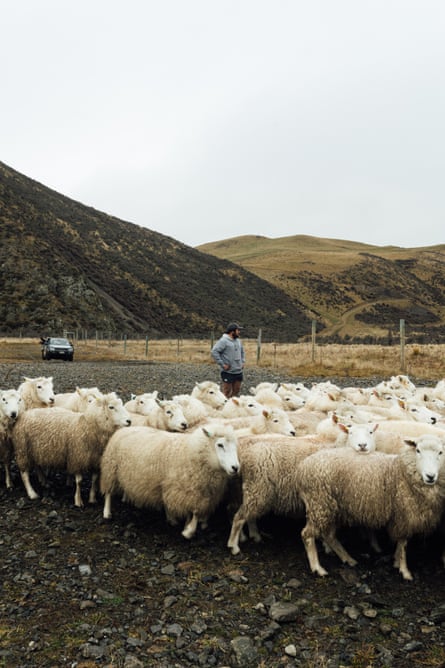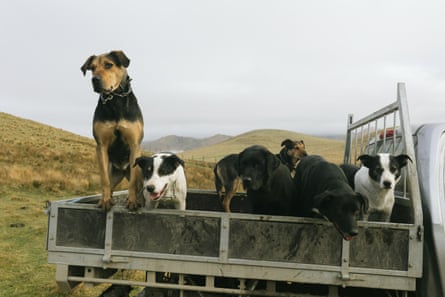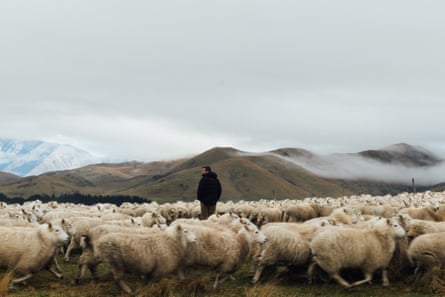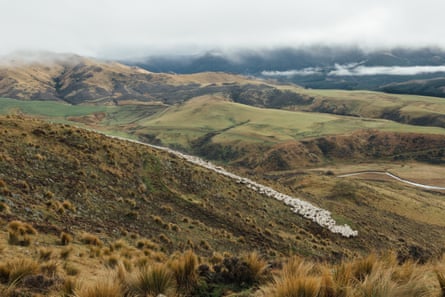Sheep numbers in sharp decline as farmers increasingly shift to forestry, fuelled by demand to earn carbon credits
Across one of the ridgelines of High Peak station, a line of sheep is on the move: gradual at first, and then in a heaving rush, an avalanche of dirty white wool heading into the valley. They flow around Hamish Guild like an eddy.
He looks across the valley, to where a slope of grassland splits in half, a velvety black expanse of pine forest sweeping over the hill.
“We’ve made a decision as a family, we’ll hold on as long as we can,” says Guild, a second-generation sheep farmer whose family has occupied this land outside Christchurch since the 1970s.
“Ultimately, if we’re an oasis in a sea of forestry, that probably gives us a distinctive, compelling selling point,” he says, and laughs. “We might become a museum: this is how we used to farm in New Zealand in the 2020s.”
These sweeping high country sheep stations, thatched by golden tussock, are at the centre of New Zealand’s international image. For almost a century, lamb, mutton and wool were New Zealand’s largest source of agricultural and national revenue, and at its 1980s peak, the ratio of sheep to humans was more than 20 to one.

Now, sheep country is in sharp decline. Across the country, farm after farm is transitioning to lucrative pine forestry, fuelled by demand for carbon credits. Under New Zealand’s emissions trading scheme, landowners can earn credits – which can be traded or sold – for activities that absorb carbon dioxide. Farmland sold for forestry conversion can now fetch prices several times higher than its previous value as agricultural land. Over tens of thousands of hectares, wire fences are being ripped out and the paddocks studded with dark bushels of pine seedlings. New Zealand’s total flock number has fallen from more than 70 million in the 1980s to just 26 million today. This year, the ratio of sheep to people slipped below 5:1 for the first time since records began.
At the same time the international wool price has plummeted, reaching the point where the cost of shearing a sheep is more than the price of its fleece. Farmers are also facing far more scrutiny over their environmental practices. But a key driver over the last decade has been the rise of forestry, which offers a way to cash out for farmers under increasing economic and political pressure.

For New Zealand’s government, forestry is a central building block of its path to emissions reduction, and agricultural emissions are its most difficult obstacle. Nearly half of New Zealand’s greenhouse gas emissions come from agriculture – mostly methane from gassy livestock. Currently, tree-planting is at the centre of its roadmap to net zero. Discussing proposed changes to the emissions trading scheme, Associate Prof David Evison from the New Zealand School of Forestry at the University of Canterbury, said that using current technologies, the country will not get to net zero by 2050 “without a significant tree planting programme”. He estimates New Zealand could need another 1.7m hectares of new forest to meet its 2050 net zero emissions target.
But that strategy is also coming under increasing scrutiny. In April, the climate commission sounded alarm about New Zealand’s overreliance on forestry, arguing that achieving a net reduction in emissions primarily through planting trees would be impossible to sustain in the long term. After cyclone Gabrielle, the damage caused by forestry debris created a huge public backlash. In June, the government announced it would be reconsidering the role of pine forest in the emissions trading scheme.
Seeing farms around his region converting into pine plantations, “there’s conflicting emotions,” says William Morrison, a sixth-generation sheep farmer from Rangitikei, in central North island. “I always loved going out on the farm, and I guess with our family being on the land for so long, there’s just a pride and passion for farming.”
For many farmers, pine represents a potential economic boon, but it comes with a huge social and cultural loss, dissolving rural communities.

After an initial flurry of employment during planting, carbon forests require very little in the way of ongoing staffing. Without farming families to sustain them, rural schools, villages and businesses can empty out. The losses can have a domino effect, Guild says. The services that sustain small towns start to shut down and as farmers become increasingly isolated, surrounded by forest, they too start to consider leaving.
Research commissioned by industry body Beef and Lamb in 2022 found that 175,000 hectares of sheep and beef farms had been sold with the intent to convert into forestry since 2017, and the rate was increasing sharply: In 2021 more than 52,000 hectares was bought by forestry interests, compared to just 7,000 hectares in 2017. Forty per cent of that land was being bought up by overseas investors, looking to add carbon forests to their portfolios.


For environmentalists, the benefits of carbon-absorbing forests are tempered by concerns about expanding monocultures of radiata pine: an introduced, fast-growing species that can wreak havoc on native ecosystems, and cause catastrophic downstream effects when harvested. As the country wrestles with how to reconcile its climate obligations and farming economy, pine forestry sits at the thorny centre of the challenge.
“Pine trees – they are an important part of our economy, they are an important part of our response to climate change,” says Erica van Reenen, who is married to Morrison and runs an environmental consultancy. But the aftermath of forestry clearing can also have devastating environmental effects. Once land has been planted with pine, it’s very difficult to change it back. “It looks like the ground has been carved up. There’s piles of debris, bare soil everywhere – which when you are someone that knows the importance of topsoil, it’s very difficult to see.” For some farmers watching the landscape transform, there’s “a hatred of pine”, van Reenen says.

At High Peak station, clusters of sheep curl in a slow-moving whirlpool. Low-lying mist covers half of the station, gradually lifting as the morning warms. It rolls back over the expanse of pasture, tussock and bracken, stretching toward the ski slopes of Mount Hutt.
“If we were to look at it purely economically, we’d probably be best to put it all into trees,” Guild says. “The impact of that on the local community will be catastrophic … If we didn’t have those farms employing young families, that would disappear. And I guess that’s the heart of the community.
“It doesn’t mean blindly keep doing what we’re doing. But we will resist the forestry thing.”
Source : The Guardian

